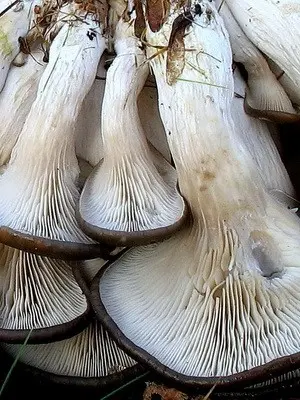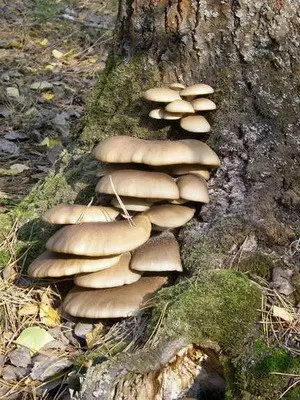 Oyster mushroom is a mushroom that is extremely valued by people who adhere to the rules of dietary nutrition. Pleurotus ostreatus is very low in calories and also useful, as it contains a lot of substances useful to the body.
Oyster mushroom is a mushroom that is extremely valued by people who adhere to the rules of dietary nutrition. Pleurotus ostreatus is very low in calories and also useful, as it contains a lot of substances useful to the body.
Below you can read the description of oyster mushroom, learn about its application and distinctive features. You will also see a photo of oyster mushroom in the forest; find out when you can start the “mushroom hunt” and get information about where oyster mushrooms grow in their natural habitat.
Category: edible.
Hat of an unusual shape (height 0,5-2 cm, diameter 6-30 cm): usually glossy, white, gray or ashy, less often brown, purple, brown, light yellow. Round and fleshy.

[ »»]
As can be seen in the photo and description of the oyster mushroom, the cap of a young mushroom has the shape of an auricle and characteristically wrapped edges. Over time, the edges straighten, and the hat becomes almost flat with characteristic wavy edges. The mushroom cap is very smooth to the touch.
Leg (height 0,5-3 cm): usually white or slightly greyish, smooth to the touch, very small or almost absent. Usually cylindrical in shape, often curved to the side, expanding from the bottom up.
Records: very rare and thin, mostly the same color as the cap.
Pulp: very juicy and dense.

Pay attention to the photo of the oyster mushroom in the context: the color of the flesh almost coincides with the hat or plates.
Oyster mushroom is a predatory fungus that can paralyze and digest some primary cavity worms due to the nematoxin contained in it. Therefore, it is practically never wormy.
Doubles: are absent.
Where and when do oyster mushrooms grow?

Where do oyster mushrooms grow: often on dead trees or rotten stumps, less commonly on dying deciduous and coniferous trees. Prefers to grow next to birches, willows and aspens.
In many countries they are grown under production conditions. In the forest, oyster mushrooms are quite unpretentious, therefore, when grown artificially, they are planted in large groups on sawdust, small shavings and even paper, waste from processing plants and vegetables (husk or straw).
When oyster mushrooms grow: from mid-September to the end of December in the countries of the Eurasian continent. Oyster mushroom prefers low temperatures, so it begins to grow with the onset of autumn. But it can also appear in the summer, if the weather is cool for a long time.
Eating: it is not only low-calorie, but also a very healthy mushroom. It contains a lot of protein, amino acids necessary for the human body, ascorbic acid, vitamin PP, phosphorus, iron and other elements.
Application in traditional medicine: does not apply.
Other names: oyster mushroom, oyster mushroom, lump.









